List of cultural monuments in Gleisweiler
In the list of cultural monuments in Gleisweiler , all cultural monuments of the Rhineland-Palatinate local community of Gleisweiler are listed. The basis is the list of monuments of the state of Rhineland-Palatinate (as of January 7, 2019).
Monument zones
| designation | location | Construction year | description | image |
|---|---|---|---|---|
| Monument zone Kurhaus Bad Gleisweiler | Badstrasse 28 location |
1844 | "Sun Temple Sanatorium"; late classicist main building under a hipped roof, 1844 by Leo von Klenze , large landscaped garden with pond and exotic trees and bushes in two parts, connected by a bridge over a public path; Garden pavilion (Sun Temple) around 1780, moved here from Landau (Schneider Brewery, Königstrasse / Kirchstrasse); in semicircular column position open on the south side, on top belvedere with parapet armor; other half-timbered garden houses from the 19th century and around 1910; Sculpture of a girl at the fountain called MDCCCLIX |
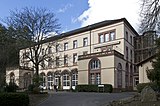
|
| Monument zone town center | Badstrasse 1–4 and 6, Bergstrasse 1–7, 9–11, 13 and 15–22, Hauptstrasse 3–25, Kirchstrasse 1–12, Kronstrasse 1–13 (odd numbers) and 2–8 (even numbers), Weinstrasse 1, 3 and 5 position |
16th to 18th century | largely closed historical building structure with picturesque street scenes, residential buildings mainly from the 16th to 18th centuries, often half-timbered; Courtyards often with archways, with Catholic and Protestant churches |
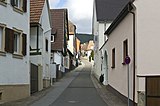
|
| Monument zone cemetery | northeast of the village on the L 507 location |
18th to 20th century | Section of the late baroque cemetery wall along Landstrasse, around 1760/62 (1780–1820?); the pillars of the entrance designed like those of the churchyard wall, enlarged in 1904; numerous tombs from the 18th and 19th centuries:
Baroque cemetery cross, 18th century, crucifix with St. Mary Magdalene, curved table pedestal ( picture ), probably at the same time tomb for the mayor Simon Fleischbein († 1784; father of the Heidelberg professor Heinrich Benedikt Fleischbein ) and the aldermen Heinrich Guthmann († 1779) |

|
Individual monuments
| designation | location | Construction year | description | image |
|---|---|---|---|---|
| Prince Luitpold Monument | Badstrasse location |
1911 | Red sandstone block with relief portrait, inscribed 1911 |
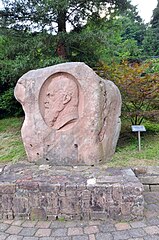
|
| Protestant Martin Bucer Church | Badstrasse 5 location |
1954 | Sandstone block construction, later Heimatstil, marked 1954, portal walls marked 1616; single-storey outbuilding with Renaissance poles, marked 1594 |
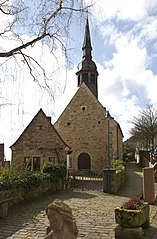
|
| Tithe courtyard and rectory | Badstrasse 7 location |
1753 | former Electoral Palatinate Zehnthof and Catholic rectory; Baroque three-wing complex, 1753, court architect S. Zeller |
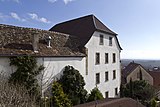
|
| front door | Badstrasse, at No. 11 location |
1827 | Front door, marked 1827 |

|
| Residential building | Badstrasse 24 location |
18th century | two-part, single-storey lower stable house, partly half-timbered, probably from the 18th century; Spolie, marked 1565 ( picture ) |
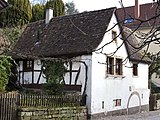
|
| Residential building | Badstrasse 26 location |
18th century | baroque lower stable house, probably from the 18th century |
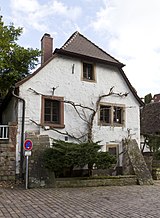
|
| Courtyard | Bergstrasse 4 location |
17th and 18th centuries | Courtyard, 17th and 18th centuries; large baroque house, 18th century; Renaissance archway, side door marked 1619; Garden with retaining wall and baroque gate |
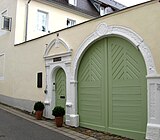
|
| Courtyard | Bergstrasse 17 location |
from the 17th century | Courtyard, from the 17th century; single-storey house above the basement, marked 1616 |

|
| town hall | Hauptstrasse 3 location |
1842 | formerly stately home; Late classical mansard hipped roof, marked 1842 |
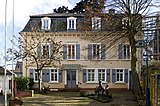
|
| Spoilage | Main street, at No. 5 location |
around 1600 | Stone of a Renaissance archway, around 1600 |
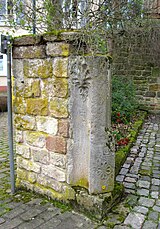
|
| Courtyard | Hauptstrasse 7 location |
1755 | late baroque courtyard; Krüppelhipped roof building, marked 1755, archway marked 1763, with the Fleischbein family coat of arms and the corresponding builder inscription; Parental home of Heidelberg theology professor Heinrich Benedikt Fleischbein (1747–1793) |
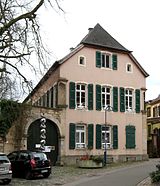
|
| Residential building | Hauptstrasse 9 location |
18th century | Residential house, stately baroque building with hipped roof, 18th century |

|
| Residential building | Hauptstrasse 14 location |
18th century | Baroque house above the high cellar, 18th century, Renaissance archway, around 1600 |

|
| Relief stone | Main street, at No. 21 location |
1787 | Relief stone, marked 1787 |
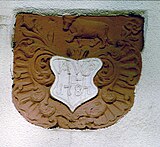
|
| Catholic parish church of St. Stephan | Hauptstrasse 22 location |
from the 14th century | Gothic former choir tower, 14th century, late baroque hall building |
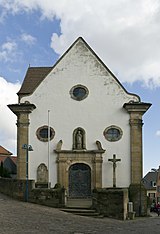
|
| Crucifix and tomb | Hauptstrasse, at No. 22 location |
from 1763 | late baroque stone crucifix, marked 1763; Tomb of S. Fleischbein, Rococo cross, around 1784 |
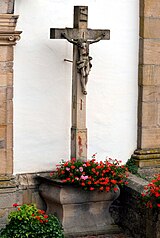
|
| Residential building | Kronstrasse 2 location |
1728 | Baroque half-timbered house above the high cellar, marked 1728 |

|
| Residential building | Kronstrasse 6 location |
around 1600 | Baroque half-timbered house, partly massive, marked 1707 and 1708 ( picture ), the core probably around 1600 |

|
| Wayside shrine | northeast of the village on the L 507 location |
16th or 17th century | Wayside shrine; late Gothic, probably from the 16th or 17th century |
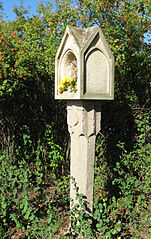
|
| Atonement crosses | northeast of the village on the L 507, on the border with Burrweiler Lage |
16th Century | Atonement crosses; Sandstone, probably from the 16th century |

|
| Mill | southwest of the village (Hainbachtal 1) location |
18th or first half of the 19th century | former mill; Closed complex with a gate, 18th or first half of the 19th century | |
| Mill | southwest of the village (Hainbachtal 3) location |
in the middle of the 19th century | former (?) mill; late classical hipped roof building, mid-19th century |
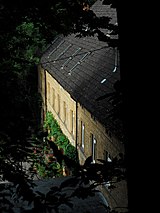 more pictures more pictures
|
| Forest shower | west of the village in the Hainbachtal location |
1849 | Forest shower; Bathing system, cold water system, 80 m long stone channel, sandstone cuboid water basin, 1849 |
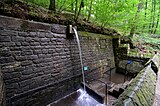
|
literature
- General Directorate for Cultural Heritage Rhineland-Palatinate (ed.): Informational directory of the cultural monuments in the Southern Wine Route district (PDF; 10.0 MB). Mainz 2019.
Web links
Commons : Kulturdenkmäler in Gleisweiler - Collection of pictures, videos and audio files